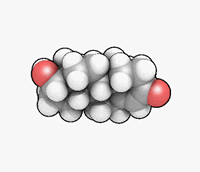show/hide words to know
Molecule: a chemical structure that has two or more atoms held together by a chemical bond. Water is a molecule of two hydrogen atoms and one oxygen atom (H2O)... more
All animals have hormones. Hormones are chemical messengers that travel through your blood. They turn some of your body's functions on or off. For example, some hormones tell your heart to beat faster when you get scared. Another hormone makes you store fat after you eat a piece of cake. Hundreds of hormones are in your body, carrying many different messages.

Hormones often use veins and arteries as highways to travel through your body.
Testosterone is one of the hormones that make men look different from women. This is because men have much more testosterone than women do. Men's high testosterone makes them grow beards and develop deeper voices. Testosterone also makes male lizards look different from female lizards, and orange-blue males different from orange males. In tree lizards, this hormone can make a male develop an aggressive personality, and a blue spot on his dewlap.
Progesterone is a hormone that is very important during pregnancy. Pregnant moms have lots of progesterone, which helps their bodies do a good job of supporting the developing baby. Male tree lizards don't get pregnant, but they have progesterone, too. In tree lizards, progesterone's effects are like testosterone's -- it causes males to develop into the aggressive orange-blue morph.

They look very similar, but progesterone, on the left, has a different role in our body than testosterone, on the right. The ball-and-stick molecules show oxygen in red, carbon in grey, and hydrogen in white.
View Citation
Bibliographic details:
- Article: Testosterone & Progesterone
- Author(s): Danika Painter
- Publisher: Arizona State University School of Life Sciences Ask A Biologist
- Site name: ASU - Ask A Biologist
- Date published: December 18, 2009
- Date accessed: April 17, 2024
- Link: https://askabiologist.asu.edu/testosterone-progesterone
APA Style
Danika Painter. (2009, December 18). Testosterone & Progesterone. ASU - Ask A Biologist. Retrieved April 17, 2024 from https://askabiologist.asu.edu/testosterone-progesterone
Chicago Manual of Style
Danika Painter. "Testosterone & Progesterone". ASU - Ask A Biologist. 18 December, 2009. https://askabiologist.asu.edu/testosterone-progesterone
Danika Painter. "Testosterone & Progesterone". ASU - Ask A Biologist. 18 Dec 2009. ASU - Ask A Biologist, Web. 17 Apr 2024. https://askabiologist.asu.edu/testosterone-progesterone
MLA 2017 Style

Rotating view of a testosterone molecule.
Be Part of
Ask A Biologist
By volunteering, or simply sending us feedback on the site. Scientists, teachers, writers, illustrators, and translators are all important to the program. If you are interested in helping with the website we have a Volunteers page to get the process started.








